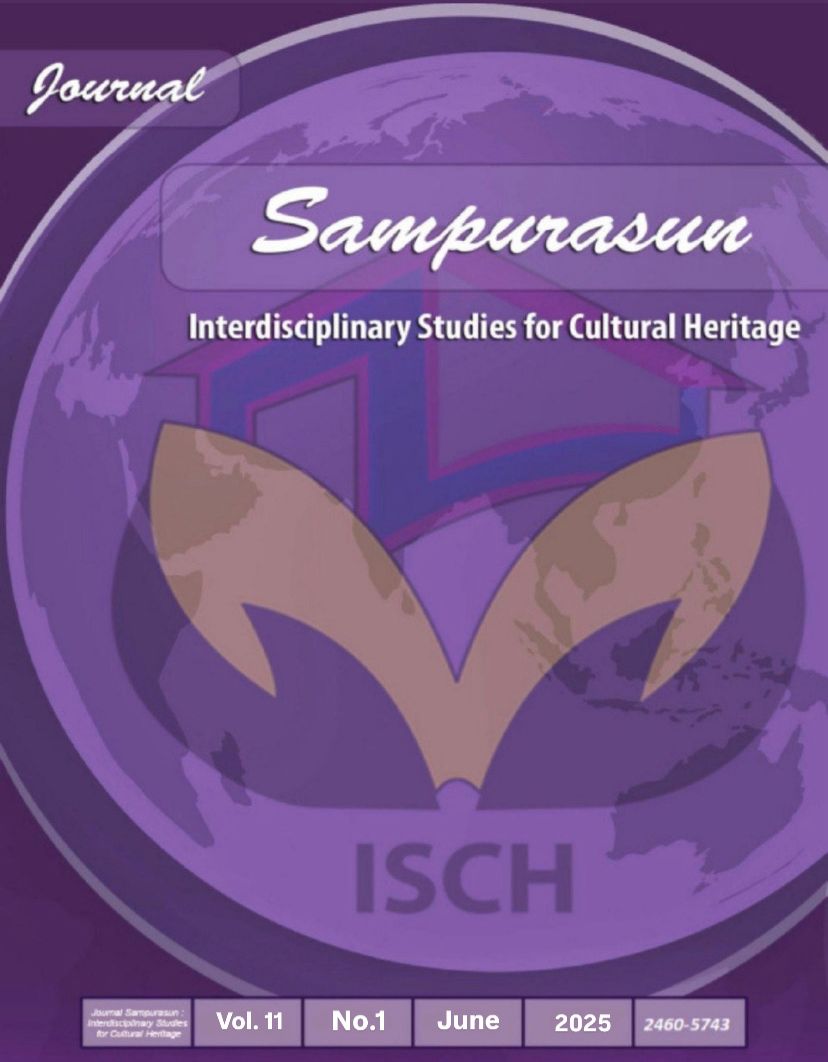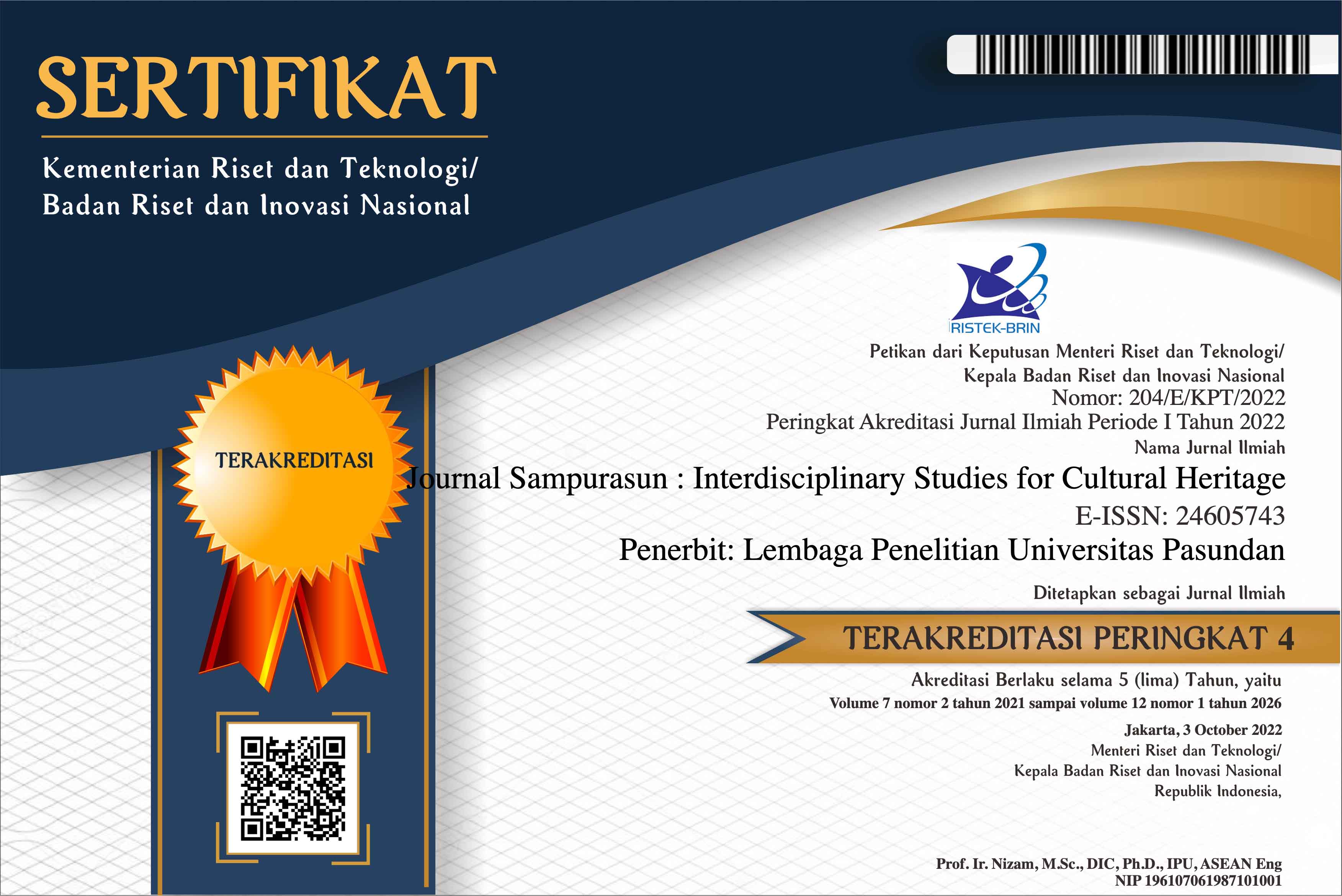FIGURATIVE LANGUAGE IN SIMPLE PLAN’S ALBUM NO PADS, NO HELMETS … JUST A BALLS: SEMANTICS AND SEMIOTICS STUDY
DOI:
https://doi.org/10.23969/sampurasun.v11i1.22759Keywords:
Keywords: figurative language, lyric analysis, popular music, simple plan, semioticsAbstract
This article purposed to conduct a comprehensive analysis of figurative language found in the lyrics of
Simple Plan's album "No Pads, No Helmets... Just Balls," as well as to explore its semiotic implications.
The background of this research is rooted in the recognition that popular music lyrics are not only artistic
expressions but also complex linguistic constructions that reflect broader cultural and emotional narratives.
Despite the widespread influence of popular music, systematic studies combining figurative language
analysis with semiotic interpretation remain limited, particularly in contemporary pop-punk genres. The
research employs a qualitative descriptive method, focusing on an in-depth examination of five selected
songs from the album. The analysis is grounded in Leech's (1981) theory of figurative language, which
categorizes various forms of figurative expressions, and Barthes' (1977) theory of semiotics, which delves
into the relationship between signs and meanings. The findings of this study reveal that the lyrics utilize
five distinct types of figurative language: metaphor, personification, hyperbole, simile, and alliteration.
Each of these elements plays a crucial role in enhancing the lyrical content, contributing to the overall
impact of the songs. This research underscores the idea that figurative language serves not only as a tool
for variation in expression but also as a powerful means to convey complex emotions and to establish a
specific atmosphere within the music. Furthermore, the semiotic analysis indicates that the lyrics
predominantly convey connotative meanings, which add layers of significance for the reader or listener.
These connotations enrich the understanding of the songs, allowing for a deeper emotional connection and
interpretation. By examining the interplay between figurative language and semiotics, this study contributes
scientifically to the fields of linguistics, literary studies, and cultural semiotics. It expands understanding
of how linguistic creativity in music can shape emotional resonance and cultural meaning, offering new
perspectives on the analysis of language in popular media. In addition, the interplay between figurative
language and semiotics contributes to a greater appreciation of how Simple Plan's lyrics resonate with
audiences, highlighting the intricate ways in which language can evoke feelings and create meaning in the context of popular music.
Keywords: figurative language, lyric analysis, popular music, simple plan, semiotics
Downloads
References
Al-qadi, M. J., & Naser, I. M. M. (2022). Lexical Relation Presentations In The Views Of Usage
Based Cognitive Semantics: The Case Of Antonymy, Synonymy, And Polysemy. Journal of
Positive School Psychology, 6(6), https://www.journalppw.com/index.php/jpsp/article/view/7653/5001
2494–2499.
Alexander, F. (2018). The Meaning of Meaning: Leech’s Seven Types of Meaning in Comparison to and
Lyons’ Approaches. PS Lexicology, 18(22), 1–15. file:///C:/Users/user/Downloads/The_Meaning_of_Meaning_Leechs_Seven_Type.pdf
Dimarco, C., Hirst, G., & Waterloo, W. (1993). The semantic and stylistic differentiation of
synonyms and near-synonyms Synonymy and plesionymy within and across languages The
limitations and selectional of role-filling restrictions. 120–127.
Eka Agustina, A., & Mustikawati, Y. (2023). Analysis of Figurative Language in Song Lyrics J.
“Make It Right” and “Permission To Dance” by Bts. ELITERATE : Journal of English
Linguistics and Literature Studies, 3(1), 2023.
Feist (2022). Significance in https://doi.org/10.4324/9781003259381 Language. In Significance in Language.
Fitrah, Y., & Afria, R. (2024). The Analysis of Synonym Relation Meaning in Kerinci Language:
A Semantic Study. Journal of Languages and Language Teaching, 12(1), 404.
https://doi.org/10.33394/jollt.v12i1.9415
Jaffré, J.-P. (2006). Pourquoi distinguer les homophones ? Langue Française, n° 151(3), 25–40.
https://doi.org/10.3917/lf.151.0025
Jarunwaraphan, B., & Mallikamas, P. (2020). A Corpus-Based Study of English Synonyms: Chance and Opportunity. REFLections, 27(2), 218–245. https://doi.org/10.61508/refl.v27i2.248710
Miharsa, S. P., & Heryono, H. (2024). Lexical Relations in Joe Biden’s Speech about Plan to Lower
Prescription Drugs Cost: Semantics Study. Linguistic, English Education and Art (LEEA)
Journal, 7(2), 333–348. https://doi.org/10.31539/leea.v7i2.9668
Pintilii, A. (2021). SYNONYMY – A PARADIGMATIC SEMANTIC RELATION BETWEEN
WORDS . WAYS OF TEACHING SYNONYMY. November.
Setianingrum, D. A., Mujiyanto, J., & Fitriati, S. W. (2021). The Use of Semantic Lexical Relation
in Rowlingâ€TMs “Harry Potter and the Deathly Hallows―. English Education Journal,
11(1), 159–165. https://doi.org/10.15294/eej.v11i1.35892
SETIAWAN NUGRAHA, D. N. (2016). Verb Go Combinations in Perspective English Linguistics
and Culture. Journal Sampurasun : Interdisciplinary Studies for Cultural Heritage, 2(01),
101. https://doi.org/10.23969/sampurasun.v2i01.115
Sha’ri, S. N., Yaakob, N. A., Mohamad Suhaizi Suhaimi, M. H. S. H., Ramely, N. A. C., Seruji, Z.,
& Ghani, R. A. (2020). Semantics in MH17 Tragedy Newspaper News. International Journal
of Academic Research in Business and Social Sciences, 10(8), 1008–1025.
https://doi.org/10.6007/ijarbss/v10-i8/7670
Shestakova, S. (2022). Neurocognitive Trends in the Model of the Lexical- Semantic Way of Word
Formation. 13, 236–251.
Smith, V., Florence, K., & Maria, F. (2018). Semantics in cultural perspective overview. Linguistics
and Culture Review, 2(1), 24–31. https://doi.org/10.37028/lingcure.v2n1.9
Sudarta. (2022). 済無No Title No Title No Title. 16(1), 1–23.
Wilks, Y., & Cognition, M. (2005). Charting a New Course: Natural Language Processing and
Information Retrieval. Charting a New Course: Natural Language Processing and
Information Retrieval, September. https://doi.org/10.1007/1-4020-3467-9
Winiharti, M. (2010). Sense Relations in Language Learning. Humaniora, 1(1), 100.
https://doi.org/10.21512/humaniora.v1i1.2152
Xian-mo, Z. (2007). Semantic relationships between contextual synonyms. US-China Education
Review, 4(9), 452–453.
Additional Files
Published
Issue
Section
License
Copyright (c) 2025 Journal Sampurasun : Interdisciplinary Studies for Cultural Heritage

This work is licensed under a Creative Commons Attribution 4.0 International License.
Copyright Notice
Authors should not withdraw their submitted papers because the withdrawal wastes voluntary works devoted by an associate editor and reviewers. But, we accept the withdrawal of a submitted paper if authors have unavoidable reasons. In the event that a manuscript is to be withdrawn from submission to Sampurasun Journal, a letter must be sent to the editorial office requesting withdrawal by e-mail (sampurasunjournal@unpas.ac.id) with its scanned PDF file, before the notification of acceptance for publication.
The withdraw request letter must include the following information. Paper ID, Paper title, Authors names, Reason why the paper must be withdrawn, and Date and signatures of all the authors (or signature of the contact author).
If only the contact author signs the letter, he/she must obtain the agreement of the withdrawal from all the other authors and the letter must include the description that all the other authors agreed the withdrawal. The journal will not withdraw a manuscript from peer review until such a letter has been received. Authors must not assume their manuscript has been withdrawn until they have received appropriate notification from the editorial office. Withdrawal of a manuscript subsequent to acceptance for publication will only be granted in the most exceptional of circumstances.
After the paper is accepted for publication, the withdrawal is not permitted in principle. The authors must always pay the charge even if the withdrawal is permitted. Any request of withdrawal that does not follow the above procedure is treated as invalid. If illegal submission, e.g., plagiarized or duplicate submission, is found for a paper, the withdrawal of the paper will never be permitted and the authors will be punished based on the rule. It is not acceptable practice to withdraw a manuscript in the event of acceptance at another journal. This constitutes dual submission. The editorial office of the other journal will be notified of your actions. In such circumstances Sampurasun ISCH may chose to impose appropriate punitive action subject.
Withdrawal Penalty
Author is not allowed to withdraw submitted manuscripts, because the withdrawal is waste of valuable resources that editors and referees spent a great deal of time processing submitted manuscript, money and works invested by the publisher. If author still requests withdrawal of his/her manuscript when the manuscript is still in the peer-reviewing process, author will be punished with paying $200 per manuscript, as withdrawal penalty to the publisher. However, it is unethical to withdraw a submitted manuscript from one journal if accepted by another journal. The withdrawal of manuscript after the manuscript is accepted for publication, author will be punished by paying US$500 per manuscript. Withdrawal of manuscript is only allowed after withdrawal penalty has been fully paid to the Publisher. If author don't agree to pay the penalty, the author and his/her affiliation will be blacklisted for publication in this journal. Even, his/her previously published articles will be removed from our online system.


















